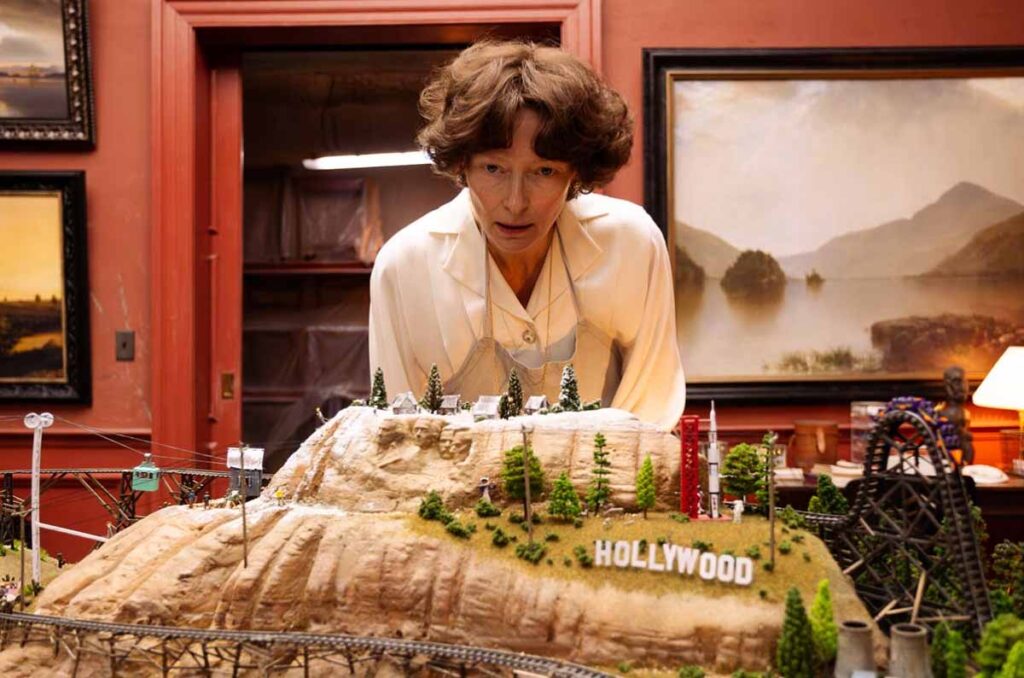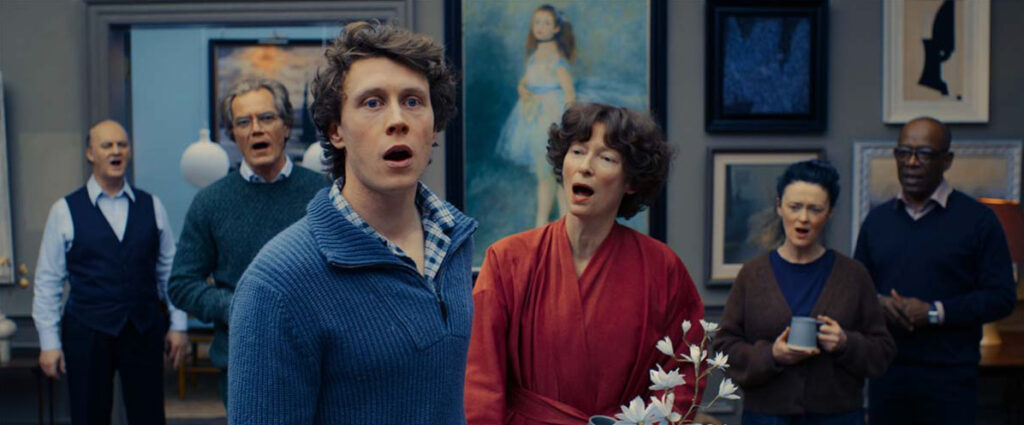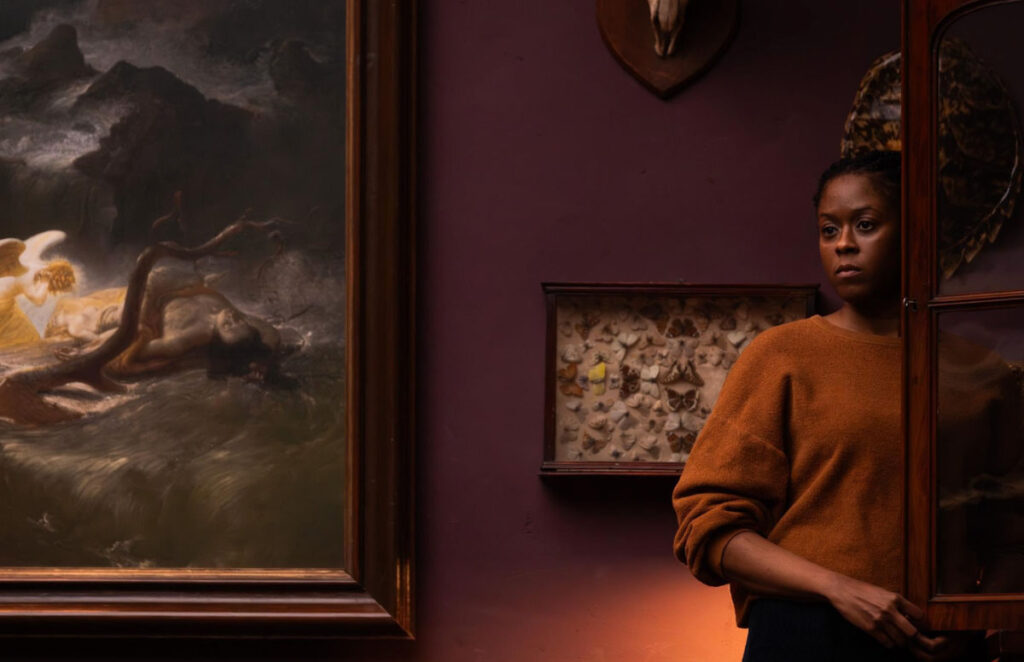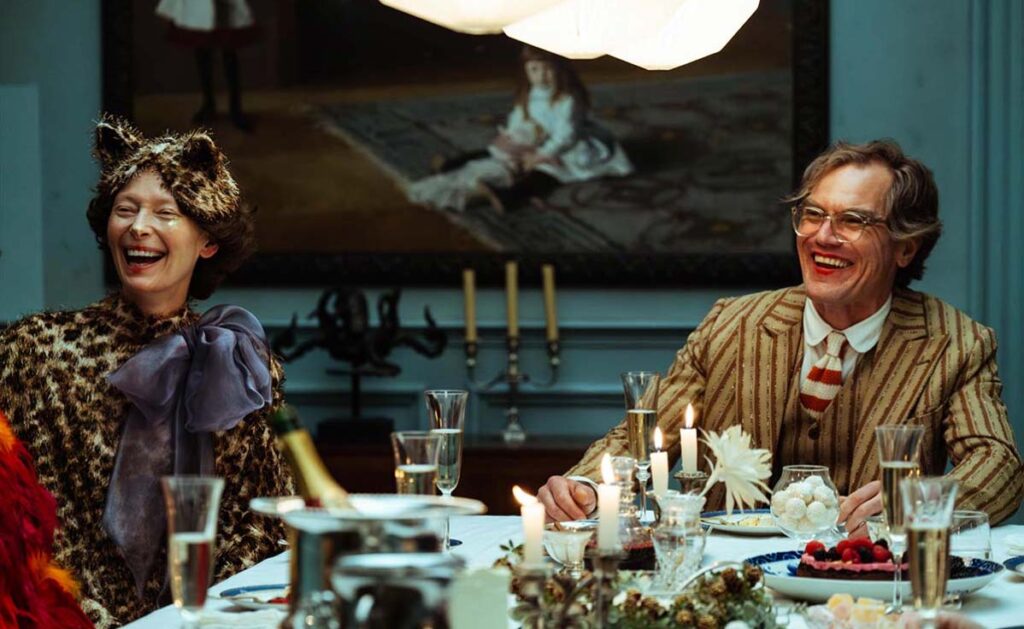
Joshua Oppenheimer’s The End: Between Musical and Mirror
Written by aleria Berghinz
Best known for his award-winning documentaries The Act of Killing (2012) and The Look of Silence (2014), Joshua Oppenheimer makes his narrative film debut with The End, a post-apocalyptic musical about family, oil, and the lies we tell ourselves to survive.
Set in a salt mine turned luxury bunker, The End follows the small family of an oil mogul (Michael Shannon) and a few of their preferred personnel as they go about life 25 years after a climate apocalypse. The walls are filled with paintings – one from each artist and movement – as selected for survival by the mercurial matriarch of the family, played by Tilda Swinton. The son of this couple (George Mackay) has only ever known the reality of this bunker, an apocalyptic Plato’s cave of sorts, wherein life is ritualised into recognisability, with Christmas and birthdays and swimming and food fights keeping spirits high. This neurotic effort at normalcy is mislabelled as hope, but the cracks tell us otherwise.

When he set out to create this film, Oppenheimer intended for it to be another documentary. He wanted to explore the irony of an oil tycoon purchasing and setting up a survival bunker but knew that his real interest lay in the aftermath of this set-up, in the 25 years after the fallout. As he tells it, this is when he went home, watched Jacques Demy’s The Umbrellas of Cherbourg (1964), and was struck by the realisation that this story would work best as a golden age musical. An unconventional choice, but one that defines the power of the film.
“The musical is the quintessential genre of deception, of illusion”, he stated at a recent Q&A screening at Picturehouse Central in London. For Oppenheimer, musicals carry themselves with such sentimentality, such romantic delusion, that they become the perfect medium through which to portray people who are lying to themselves. “The sentimentality here is often a deluded hope”, he said. So the medium becomes the message, a cinematic language of posturing self-deception.

It is not the first time that Oppenheimer has employed this somewhat unconventional perspective on the possibilities of the musical. In his documentary The Act of Killing, Oppenheimer interviewed the perpetrators of the Indonesian 1960’s massacre of an estimated 500,000 to 3 million communists. So many decades after the fact, Oppenheimer had them recreate the murders in different cinematic genres, such as the Western and the Musical. The men did so enthusiastically, at least until they went to watch the recordings and revealed a more complex understanding of their performances. Oppenheimer was interested in the cracks of their personas, where a more human truth could glimmer through.
Delusion and its cracks – it’s the thesis which Oppenheimer carries from his past work over to The End. The family and workers of this luxury bunker may very well think of themselves as normal, living within recognisable structures, but their voices crack when they sing and the truth rings in the subsequent silence.
The arrival of a girl (Moses Ingram), a survivor of the burning desolation of the outside world, shakes the confidence of the bunker’s structures of delusion. She is taken in by the family, an act of charity which they hope will absolve them of their guilt in the roaring flames ravaging earth. And her perspective does shake the family, but the foundations had always been brittle, and nothing seems strong enough a push to change their ways.

In his Q&A, Oppenheimer spoke of the biblical Book of Revelation, wherein God sends a premonition of the apocalypse to John so that he may pass this knowledge on to the rest of humanity. Oppenheimer makes the argument that we are the first people to whom the extinction of humanity has been revealed. We have the visuals – earthquakes, tsunamis, fires – we have estimated timelines and, most notably, we have instructions for prevention. And yet, in the age of Donals Trump’s “drill, baby drill”, we seem to be doing nothing but deluding ourselves into inaction.
The film carries the weight of this message, acting as a warning for the audience, another of the many mirrors which are held up during its own musical numbers. The performances in the film are fantastic, easing the weight of a slightly too long run-time. The End is a strange film, theatrical in its limited cast and set, cinematic in its musical numbers, and documentary-like in the anthropological interest it takes in its characters. It does not reach the soaring entertainment heights that musicals usually do, but it reimagines the medium in a way that is fresh and purposeful.
Oppenheimer asks us to consider our own Plato’s cave, one constructed of social media feeds and emoji reactions. It is a new language of engagement which “determines the limits of our solidarity” and our wilfulness to make a change. The End is not only a satire of oil moguls and doomsday preppers, but a reflection of our own uneasy comforts and the time we still have to be honest with ourselves and each other. Oppenheimer closed the discussion by asking: in the face of doom, “how then shall we live?”
